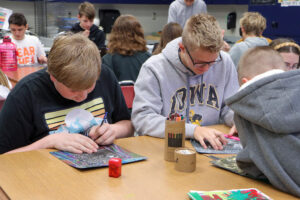
Middle School Students Build Art and Creative Thinking Skills
At Oak Ridge and Excelsior Middle Schools, seventh and eighth grade students are offered a unique opportunity to explore their creativity and develop new skills through art classes. These classes provide an engaging environment where students can experiment with various techniques, learn about different artistic styles, and express themselves in meaningful ways.
What Students Learn Throughout the Quarter
In both seventh and eighth grade, students work on a variety of projects that help them build both technical skills and creative problem-solving abilities. According to Oak Ridge Art Teacher Curt Hynek, the curriculum includes a mix of two-dimensional and three-dimensional projects. “We focus on drawing, perspective, portraits, and color, along with three-dimensional projects like clay, sculpture, and even watercolor and oil pastels,” he explained. “By the end of the quarter, students will have explored different mediums and techniques.”
Hynek’s 8th graders, for example, recently worked on their final clay project, where they learned how to use a pottery wheel to make a bowl. “The goal is to give them an introduction to ceramics before they head to high school,” Hynek said. “Some may love it, others might find it messy, but it’s a great way to try something new.”
The Importance of Art Classes
Students also gain hands-on experience with various art forms such as sculpture, painting, and drawing, giving them a chance to experiment with different materials like paper, wire, and cardboard. Hynek emphasizes the importance of creativity in these projects. “The great thing about art is that it’s creative problem-solving. There’s no one right answer, and students can meet the same standards in many different ways,” he said.
Excelsior Art Teacher Dr. Sarah Hale-Keuseman focuses on helping eighth graders understand the artistic process. “We really focus on reflecting on what students are doing and the big ideas behind their artwork,” she explained. “We also build technical skills and explore different artistic styles.” Recently, her students have been working on metal sculptures, using relief techniques to create abstract and nonobjective art. “It’s been incredible watching them create something new, especially when many of them didn’t think they could do it,” she said.
In Hale-Keuseman’s class, students learn to appreciate the process of creating art, from the initial idea to the final piece. “My hope is that they take away an understanding of creativity as a skill that can be developed,” she said. “I want them to be critical thinkers and to recognize how art can be a form of self-expression and communication.”
Both teachers believe that these art classes provide much more than just technical skills; they help students build confidence in their creativity. “Students are often surprised by what they can accomplish,” Hynek said. “It’s great to see them proud of their work and understand that their creativity is something they can keep developing.”
For many students, these art classes offer a refreshing break from other subjects, allowing them to engage in hands-on learning and experience self-expression. The skills and creativity they develop in these classes will serve them well, both in future artistic endeavors and in their ability to think critically and creatively in other areas of life.






